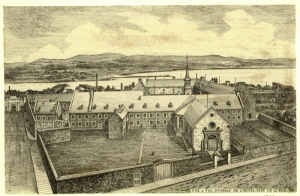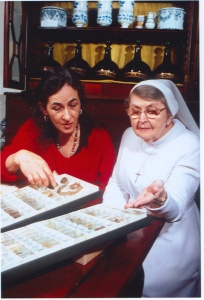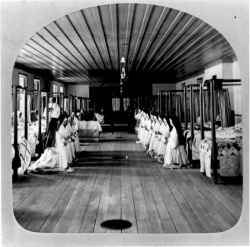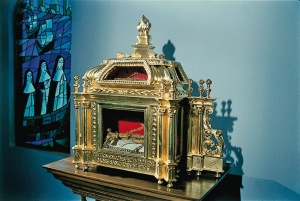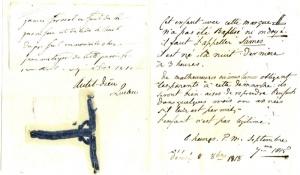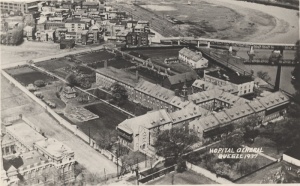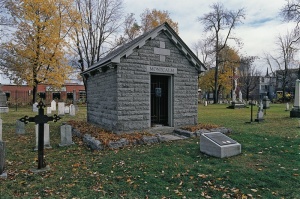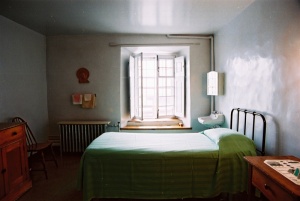
The Augustinian Monastery of Quebec
par Simard, Jean
In 2000 the Augustines de la Miséricorde de Jésus religious community decided to assemble the archives and collections from their twelve monasteries under one roof and to make this treasure trove of information available to the public as part of the Graven In Our Memories project. The Augustinians opted to exhibit their heritage at the Hôtel-Dieu de Québec monastery, built in Quebec City’s Upper Town in the years after the first members of the order arrived in 1639. The Lower Town premises of Hôpital-Général de Québec—which also date back to the 17th century—will be integrated into this heritage complex, to be known as Monastère des Augustines (the Augustinian monastery).
Article disponible en français : Monastère des augustines de Québec
Graven In Our Memories
Aware of the significance of their heritage and spurred into action by their diminishing numbers, Augustinians from all over Quebec decided in 2000 to assemble their archives and collections under one roof at the Hôtel-Dieu de Quebec monastery and to transform the site into a place of remembrance—Monastère des Augustines. The monastery has been invested with the following mission:
« Through its cultural and social vocation, Monastère des Augustines bears witness to the way of life and the social and spiritual mission of the Augustinians of Quebec. Inspired by the devotion and compassion of the Augustinians, the monastery will be a place where their traditions of welcome, hospitality, remembrance and healing will live on ».
Mario Dufour, a priest from the Québec diocese and a cultural heritage expert, first thought up the project. Seven committees were set up in 2005, bringing together some sixty people to advise the Augustinians on the content of the project and on how to make it a reality. The decision was made to convert the monastery premises while the nuns were still living there so that they could pass on their intangible heritage (i.e., their knowledge and know-how) to future generations. The team decided there was no point conserving artistic and historic items if there was no one left tomorrow to name them or explain what they had been used for. Objects stand alone, often in silence, and while archives can sometimes reveal their secrets, it is the bearers of tradition—in this case the nuns—who lend meaning to tangible heritage by transmitting the intangible heritage that goes along with it. With this in mind, a photo campaign was launched in 2008 to capture the site’s spirit, character and atmosphere. In keeping with the Augustinians’ vocation, the centuries-old buildings will also house a resource centre for informal caregivers as well as accommodations for caregivers and for visitors interested in a unique heritage experience. In addition, Centre Catherine-de-Saint-Augustin will continue to raise the profile of the work and spirituality of Blessed Catherine of St. Augustine (1632–1668). Part of the Monastère des Augustines complex will also be housed in the historic buildings of Hôpital-Général de Québec.
The Augustinian Heritage
Monastère des Augustines will feature archives and collections from the following 12 monasteries: Hôtel-Dieu de Québec (1639), Hôpital-Général de Québec (1692), Hôtel-Dieu du Sacré-Coeur (1873, also in Québec City), Hôtel-Dieu de Chicoutimi (1884), Hôtel-Dieu de Lévis (1892), Hôtel-Dieu de Roberval (1918) Hôtel-Dieu de Gaspé (1926), Hôtel-Dieu de Saint-Georges de Beauce (1949), Hôtel-Dieu de Montmagny (1951), Hôtel-Dieu d’Alma (1954), Hôtel-Dieu de Jonquière (1955) and Hôtel-Dieu de Dolbeau (1955). Once assembled, the archives and old books from the monasteries will stretch for 902 meters. They will be curated by Centre d’archives des augustines. As for the 24,000 items in the monastery collection, they will take up 1,980 cubic meters. Some of them will be displayed in the museum, others in the living areas of the monastery. The most precious of these heritage treasures, which are described below, belonged to Hôtel-Dieu de Québec and Hôpital-Général de Québec, both of which date back to the days of New France.
Hôtel-Dieu de Québec
Buildings
The Augustinians of Dieppe, France, arrived in Quebec in 1639 and set up
temporary quarters in Sillery until their Hôtel-Dieu—or hospital—was completed
in 1644. Thirty years later the site housed a monastery, chapel and two wards for
the sick. In 1695 two new wings were added to the existing buildings to form a
square courtyard. Fire ravaged the premises in 1755, leaving only one 1695 wing
and the “noviciate” wing from 1739–1740 in usable condition. Reconstruction work
began in 1756 and lasted until 1758. A chapel, also overlooking Rue Charlevoix,
was built between 1800 and 1803. The chapel and some of the works of art it
contained were classified historic monuments by the Quebec government in 1961.
The monastery, its grounds, the surrounding wall, and neighbouring buildings
were classified a historic site in 2003.
Collections
On December 15, 2000, concerned about what might happen to their heritage in the future, the Augustinians of Hôtel-Dieu de Québec drew up an application to have their collection classified as cultural property. A series of studies were commissioned to make an inventory of the heritage assets of the three Québec City Augustinian communities (Hôtel-Dieu de Québec, Hôpital-Général de Québec, and Hôtel-Dieu du Sacré-Cœur) with a view to reorganizing the Augustinians’ premises and bringing their assets together under one roof in the Upper Town.
A total of 8,466 objects were inventoried in the Hôtel-Dieu de Québec collection, ranging from the centuries-old furnishings in the monastery to the items housed in the museum that the Augustinians opened in 1958 to mark Quebec City’s 350th anniversary. The invaluable collection contains numerous pieces of furniture and many items made from gold, silver, copper, brass, and tin, in addition to clocks, ceramics, clothing, embroidered liturgical accessories, tapestries, paintings, statues, basketwork, aboriginal art, wax works, apothecary items, and medical instruments. Over 500 objects dating back to the French Regime were classified in 2003. The inventory coordinator noted that very few collections in Quebec can be dated and sourced with such certainty. This particular collection includes over 50 objects donated by well-known figures of New France, such as the Duchesse d’Aiguillon, Madame d’Ailleboust and Madame Des Meloizes, the Augustinians of Dieppe, the Carmelites of Paris, the Jesuits of Quebec, Governor Rémy de Courcelle and Intendant Jean Talon. Generally speaking, items were acquired to meet the needs of the monastery and hospital and have remained on site—and inseparable from it—ever since. As a result, the collection constitutes a remarkable record of Quebec’s political, economic, social, scientific, and religious history.
Archives and Books
Among the hundreds of meters of archival materials preserved by the
Augustinians at Hôtel-Dieu de Québec, two archival fonds contain documents that
date back to the French Regime: one from the Augustines de la Miséricorde de
Jésus community at the Hôtel-Dieu de Québec monastery (1637–1995) and the other
from Hôtel-Dieu de Québec (1664–1997). The first describes the nuns’ material
and spiritual lives and contains such items as the donation contract signed by the
Duchesse d'Aiguillon (1637), letters patent from Louis XIII (1639), and the
rules of the community (1631 and 1768). There is also a book fonds (1601–1900).
Over a third of its 2,800 volumes date from the 17th and 18th
centuries, and although most of them are on religion, some also look at music,
medicine, and cooking. These archival fonds along with the book fonds and two
others belonging to the Augustinians at Hôtel-Dieu were all classified in 2003.
Hôpital-Général de Québec
The Oldest Religious Buildings North of Mexico
In 1692 Monsignor Jean-Baptiste de La Croix de Chevrières de Saint-Vallier purchased the Récollet convent and church in Quebec City’s Lower Town to set up a general hospital for the poor, the sick and the elderly. The following year, a number of Augustinians left Hôtel-Dieu to take charge of the new hospital—where the order remains to this day. The community became autonomous in 1699 in keeping with the wishes of its founder, Mgr de Saint-Vallier. In 1721, Mgr de Saint-Vallier also took steps to constitute the hospital—which at the time included a vast farm surrounding the buildings—as a separate parish, Notre-Dame-des-Anges. The Augustinian convent and hospital in the Lower Town have had the good fortune to be spared by fire, making them the oldest religious buildings north of Mexico. However, the original structures have seen many additions over the years. Today, the complex comprises 20 wings, the result of 26 construction projects spread over 337 years. Close to the monastery on what is today Boulevard Langelier, Mgr de Saint-Vallier had a wooden windmill built for the Augustinians in 1710. It was replaced in 1731 by a stone windmill, which still stands to this day. The hospital site was classified in 1977.
Cemeteries
There are three historic cemeteries on the hospital grounds. One of them was
created in 1728 for the poor. It officially became the Hôpital-Général de Québec
Cemetery in 2001 and is the only Seven Years’ War cemetery in the world. It
contains the remains of 1,058 French, English, Canadian, and aboriginal
soldiers who died in the war between 1753 and 1760 and on the Plains of Abraham
in 1759. Many of the soldiers were treated by the nuns, and their names
recorded in the general hospital archives. In 2001 the remains of General
Montcalm—till then kept by the Ursulines of Quebec City—were moved to a
mausoleum bearing his name, and also home to 17 of his peers. The cemetery
contains the largest known concentration of French officers decorated as Chevaliers
de Saint-Louis, a high distinction under France’s Ancien Regime.
Collections
In December 2000, as part of efforts described above, the Augustinians of
Hôpital-Général applied to have their property and archives classified. New
reports were produced and 4,271 objects were inventoried, 758 of which date from
the 16th, 17th, and 18th centuries. Highlights
of the collection include an altar painting by Brother Luc (1670–1671) from the
Récollet church and 21 landscapes on church panels thought to have been painted
by Mother Maufils in 1697. The collection is similar to the Hôtel-Dieu
collection in terms of age, rarity, authenticity, integrity, and documentary value.
Indeed, the Augustinians of Hôpital-Général opened a museum in 1960 to share
the finest objects from the collection with the public.
Archives and Books
The Hôpital-Général archival fonds contains 52 meters of documents from 1631 to 1999 and also includes 1,560 works published from 1597 to 1900. The inventory coordinator recommended the fonds be classified because of its uniqueness, age, and the wealth of rare information it contains on the social, economic, political, military, and religious history of Quebec City and the surrounding area. The fonds sheds light on the development and management of the seigneurial regime as well as on changes in attitudes toward the poor and elderly and in how they were treated. It also documents the various armed conflicts that shook the colony, particularly the Seven Years’ War. The remarkable continuity of various series and the fonds’ excellent condition make it even more valuable.
Graven In Our Memories: Aims and Challenges
Creating a place of
remembrance to preserve the Augustinians’ rich heritage and perpetuate their
mission has been a major challenge, but will undoubtedly inspire other
religious communities to follow suit.
The collections and archives from the 12 Augustinian monasteries assembled at Hôtel-Dieu
de Québec alongside the members of the community who reside there still constitute
a remarkable testimony to the French presence in North America from the 17th
century to the present day, and a remarkable record of the religious orders and
the hospitals they ran. The Augustinians, who first arrived as a new country
was being born, are now preparing to pass on their material and spiritual
heritage through a project that will preserve and maintain their traditions of
welcome, hospitality, remembrance and healing for future generations.
Jean Simard
Retired professor of ethnology
Université Laval
BIBLIOGRAPHY
Bernier, Hélène, Le patrimoine des augustines du monastère de l'Hôtel-Dieu de Québec. Archives et livres anciens, Québec, Ville de Québec et ministère de la culture et des Communications du Québec, 2001.
Bernier, Hélène, Le patrimoine des augustines du monastère de l'Hôpital général de Québec. Archives et livres anciens, Québec, Ville de Québec et ministère de la Culture et des Communications du Québec, 2002.
Desmeules, Claire, Le patrimoine des augustines du monastère de l'Hôtel-Dieu de Québec. Collection de biens mobiliers. Analyse et recommandations, Québec, Ville de Québec et ministère de la Culture et des Communications du Québec, 2001.
Desmeules, Claire, Le patrimoine des augustines du monastère de l'Hôpital général de Québec. Collection de biens mobiliers. Analyse et recommandations, Québec, Ville de Québec et ministère de la Culture et des Communications du Québec, 2003.
Robitaille, Denis, Le Monastère des Augustines. Le temps des décisions. Le lieu de mémoire habité des Augustines de la Miséricorde de Jésus. Rapport, juin à décembre 2007.
Simard, Jean, Le patrimoine immatériel des augustines de l'Hôtel-Dieu de Québec. Rapport d'enquête orale préparé sous la direction de Jean Simard, assisté de David Harvengt, par Nicole Bourgault, Denis Croteau, Véronique Dupont, Véronique Labonté, Karine Laviolette, Madeleine Pastinelli et Sophie Pomerleau. Québec, Université Laval, mai 1997.
Trépanier, Paul, Le patrimoine des augustines du monastère de l'Hôtel-Dieu de Québec. Étude de l'architecture, Québec, Ville de Québec et ministère de la Culture et des Communications du Québec, 2001.
Trépanier, Paul, Le Patrimoine des augustines du monastère de l'Hôpital général de Québec. Étude de l'architecture, Québec, Ville de Québec et ministère de la Culture et des Communications du Québec, 2002.

Additional DocumentsSome documents require an additional plugin to be consulted
Images
-
 Augustine priant dans
Augustine priant dans
le corridor de... -
 Compassion
Compassion
-
Corridor de l'aile du
Jardin, monast... -
 Denis Croteau interro
Denis Croteau interro
ge sœur Thérèse...
-
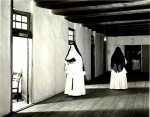 Dortoir du monastère
Dortoir du monastère
des augustines ... -
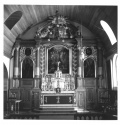 Église de l’Hôpital g
Église de l’Hôpital g
énéral de Québe... -
 Grande salle du novic
Grande salle du novic
iat, monastère ... -
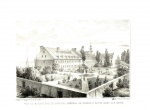 Hôpital général de Qu
Hôpital général de Qu
ébec.
-
 Hôpital général de Qu
Hôpital général de Qu
ébec. -
 Hôtel-Dieu de Québec
Hôtel-Dieu de Québec
et cimetière de... -
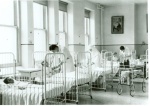 Hôtel-Dieu de Québec,
Hôtel-Dieu de Québec,
salle de pédia... -
 Jardin du monastère d
Jardin du monastère d
e l’Hôtel-Dieu ...
-
La tournée des médeci
ns. Salle Saint... -
 Les augustines dans l
Les augustines dans l
a chapelle cove... -
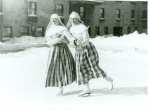 Les augustines de l’H
Les augustines de l’H
ôtel-Dieu de Qu... -
Lettres patentes de L
ouis XIII autor...
-
 Mémorial de la guerre
Mémorial de la guerre
de Sept Ans (1... -
Monastère des augusti
nes de l’Hôtel-... -
Premier feuillet du R
egina Caeli de ... -
 Prise d’habit chez le
Prise d’habit chez le
s augustines de...

